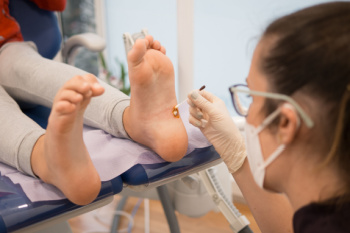
Plantar warts, though benign, are contagious and can be a source of discomfort for many individuals. These small, grainy growths typically develop on the soles of the feet, particularly in areas that bear weight such as the heel or ball of the feet. Plantar warts are caused by the human papillomavirus, or HPV, specifically strains that thrive in warm, moist environments. Plantar warts often enter the body through tiny cuts or breaks in the skin. Walking barefoot in public places like locker rooms, swimming pools, or communal showers can increase the risk of exposure to the virus. Additionally, individuals with weakened immune systems or compromised skin integrity are more susceptible to developing plantar warts. The pressure and friction exerted on the feet during walking can flatten plantar warts, causing them to grow inward and become painful. While plantar warts may resolve on their own over time, seeking treatment from a podiatrist can help alleviate discomfort and prevent them from spreading to other areas of the feet or to other individuals. If you have developed a plantar wart, it is suggested that you visit a podiatrist who can offer effective treatment solutions.
Plantar warts can be very uncomfortable. If you need your feet checked, contact one of our podiatrists from McKinney Podiatric Associates, PA. Our doctors will assist you with all of your foot and ankle needs.
About Plantar Warts
Plantar warts are the result of HPV, or human papillomavirus, getting into open wounds on the feet. They are mostly found on the heels or balls of the feet.
While plantar warts are generally harmless, those experiencing excessive pain or those suffering from diabetes or a compromised immune system require immediate medical care. Plantar warts are easily diagnosed, usually through scraping off a bit of rough skin or by getting a biopsy.
Symptoms
Treatment
To help prevent developing plantar warts, avoid walking barefoot over abrasive surfaces that can cause cuts or wounds for HPV to get into. Avoiding direct contact with other warts, as well as not picking or rubbing existing warts, can help prevent the further spread of plantar warts. However, if you think you have developed plantar warts, speak to your podiatrist. He or she can diagnose the warts on your feet and recommend the appropriate treatment options.
If you have any questions please feel free to contact one of our offices located in Pasadena, Baytown, League City, Houston, and Pearland,TX . We offer the newest diagnostic and treatment technologies for all your foot and ankle needs.

Foot corns develop in response to the persistent pressure or friction exerted on specific areas of the feet. This pressure often occurs on the toes, the tops of the feet, or between toes, where bones are close to the surface of the skin. Various factors contribute to the formation of foot corns. Age-related changes in foot structure and biomechanics can impact gait and alter the way shoes fit, leading to increased friction and corn development. Wearing ill-fitting socks or shoes, whether too tight or too loose, can cause constant rubbing against the skin. Obesity can further complicate matters by causing abnormal weight distribution and contributing to foot deformities, like flat feet or hammertoes, which increase pressure on certain areas of the feet. Conditions such as osteoarthritis or diabetes also heighten the risk of foot corns. In the case of diabetes, peripheral neuropathy can impair sensation in the feet, making it difficult to detect and address areas of excessive pressure or friction. Consulting a podiatrist for persistent foot corns is suggested, as this medically trained foot doctor can provide personalized treatment and guidance.
Corns can make walking very painful and should be treated immediately. If you have questions regarding your feet and ankles, contact one of our podiatrists of McKinney Podiatric Associates, PA. Our doctors will treat your foot and ankle needs.
Corns: What Are They? And How Do You Get Rid of Them?
Corns are thickened areas on the skin that can become painful. They are caused by excessive pressure and friction on the skin. Corns press into the deeper layers of the skin and are usually round in shape.
Ways to Prevent Corns
There are many ways to get rid of painful corns such as:
Treating Corns
Although most corns slowly disappear when the friction or pressure stops, this isn’t always the case. Consult with your podiatrist to determine the best treatment option for your case of corns.
If you have any questions please feel free to contact one of our offices located in Pasadena, Baytown, League City, Houston, and Pearland,TX . We offer the newest diagnostic and treatment technologies for all your foot and ankle needs.
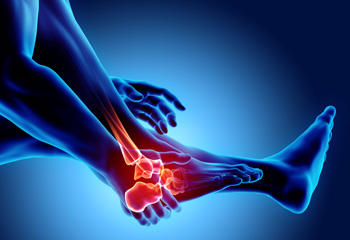
Foot injuries are common among athletes and individuals engaged in high-impact activities, but understanding the difference between a stress reaction and a fracture is critical for proper diagnosis and treatment. A stress reaction, also known as a stress response, occurs when the bones of the foot undergo repetitive stress without adequate time for recovery, resulting in microscopic damage to the bone. Symptoms include localized pain and swelling, particularly during activity, which typically improves with rest. In contrast, a fracture involves a complete or partial break in the bone due to sudden trauma or excessive force. Fractures often present with more severe pain, swelling, bruising, and sometimes deformity at the site of injury. While stress reactions may not always be visible on imaging tests like X-rays, fractures typically show up clearly. If you have foot pain, and feel it may be a stress fracture, it is suggested that you visit a podiatrist as quickly as possible who can guide you toward appropriate treatment options.
Activities where too much pressure is put on the feet can cause stress fractures. To learn more, contact one of our podiatrists from McKinney Podiatric Associates, PA. Our doctors can provide the care you need to keep your pain free and on your feet.
Dealing with Stress Fractures of the Foot and Ankle
Stress fractures occur in the foot and ankle when muscles in these areas weaken from too much or too little use. The feet and ankles then lose support when walking or running from the impact of the ground. Since there is no protection, the bones receive the full impact of each step. Stress on the feet can cause cracks to form in the bones, thus creating stress fractures.
What Are Stress Fractures?
Stress fractures occur frequently in individuals whose daily activities cause great impact on the feet and ankles. Stress factors are most common among:
Symptoms
Pain from the fractures occur in the area of the fractures and can be constant or intermittent. It will often cause sharp or dull pain with swelling and tenderness. Engaging in any kind of activity which involves high impact will aggravate pain.
If you have any questions please feel free to contact one of our offices located in Pasadena, Baytown, League City, Houston, and Pearland,TX . We offer the newest diagnostic and treatment technologies for all your foot and ankle needs.
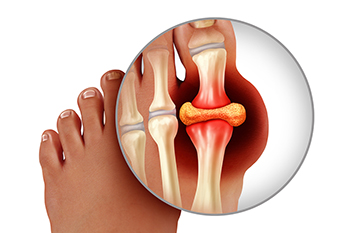
Gout, a form of inflammatory arthritis, occurs when uric acid accumulates in the joints, leading to the formation of needle-like crystals. This condition, often characterized by sudden, intense pain, typically targets the big toe but can affect any joint. The primary culprit is an excess of uric acid, a byproduct of purine metabolism, causing inflammation and debilitating discomfort. Individuals grappling with gout frequently experience swelling, redness, and extreme tenderness in the affected joint, making movement excruciating. While the big toe is a common target, gout can also strike joints in the ankles, knees, wrists, and fingers. The pain, often reaching its peak within hours, can be relentless and accompanied by lingering discomfort. Recognizing the definition and symptoms of gout is pivotal for prompt diagnosis and effective management. If you have pain in your big toe, it is strongly suggested that you visit a podiatrist who can properly diagnose, treat, and manage gout or any other condition it might be.
Gout is a foot condition that requires certain treatment and care. If you are seeking treatment, contact one of our podiatrists from McKinney Podiatric Associates, PA. Our doctors will treat your foot and ankle needs.
What Is Gout?
Gout is a type of arthritis caused by a buildup of uric acid in the bloodstream. It often develops in the foot, especially the big toe area, although it can manifest in other parts of the body as well. Gout can make walking and standing very painful and is especially common in diabetics and the obese.
People typically get gout because of a poor diet. Genetic predisposition is also a factor. The children of parents who have had gout frequently have a chance of developing it themselves.
Gout can easily be identified by redness and inflammation of the big toe and the surrounding areas of the foot. Other symptoms include extreme fatigue, joint pain, and running high fevers. Sometimes corticosteroid drugs can be prescribed to treat gout, but the best way to combat this disease is to get more exercise and eat a better diet.
If you have any questions please feel free to contact one of our offices located in Pasadena, Baytown, League City, Houston, and Pearland,TX . We offer the newest diagnostic and treatment technologies for all your foot and ankle needs.
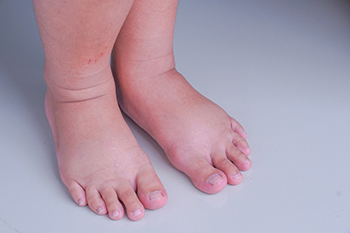
Swollen feet, a common occurrence, can be attributed to various factors that impact the delicate balance of fluid regulation in the body. One primary cause is fluid retention, often linked to prolonged periods of standing or sitting, particularly in hot weather. The force of gravity hinders efficient circulation, leading to fluid pooling in the lower extremities. Additionally, dietary choices high in sodium can contribute to water retention, exacerbating swelling. Injuries or trauma, such as sprains or fractures, may trigger localized swelling as the body's natural response to inflammation. Conditions like venous insufficiency or deep vein thrombosis disrupt blood flow, promoting fluid accumulation. Pregnancy and hormonal fluctuations can also lead to swelling in the feet. If your feet are swollen, it is suggested that you consult a podiatrist who can determine what the cause is, and offer appropriate relief methods.
Swollen feet can be a sign of an underlying condition. If you have any concerns, contact one of our podiatrists of McKinney Podiatric Associates, PA. Our doctors can provide the care you need to keep you pain-free and on your feet.
Swollen feet are a common ailment among pregnant women and people who stand or sit for extended periods. Aging may increase the possibility of swollen feet and patients who are obese often notice when their feet are swelling too. There may be medical reasons why swollen feet occur:
Swollen feet can also be caused by bone and tendon conditions, including fractures, arthritis, and tendinitis. Additionally, there may be skin and toenail conditions and an infection may cause the feet to swell. Patients who take medicine to treat high blood pressure may be prone to getting swollen feet.
Many patients elevate their feet to help relieve the swelling and this is generally a temporary remedy. When a podiatrist is consulted the reason behind the swelling can be uncovered and subsequently treated.
If you have any questions please feel free to contact one of our offices located in Pasadena, Baytown, League City, Houston, and Pearland,TX . We offer the newest diagnostic tools and technology to treat your foot and ankle needs.

Pregnancy is a transformative journey, both physically and emotionally. While many anticipate changes in their bodies, some may not be aware of the potential foot conditions that can arise during this time. One common issue is edema, or swelling of the feet and ankles, which results from increased blood volume and the pressure on leg veins. This can cause discomfort, but it is often temporary. Another condition linked to pregnancy is flat feet. Hormonal changes during pregnancy can affect the ligaments in the feet, leading to a decrease in arch height. This can contribute to foot pain and discomfort. Additionally, weight gain can place added stress on the feet, often causing pain and fatigue. The expanding uterus may also shift the center of gravity, altering the gait and potentially causing problems like plantar fasciitis. Pregnancy can bring about various foot challenges, but with proper care, many of these issues can be managed or prevented. If you have developed any type of foot conditions during your pregnancy, it is suggested that you schedule an appointment with a podiatrist who can monitor any foot pain or discomfort you may be experiencing.
Pregnant women with swollen feet can be treated with a variety of different methods that are readily available. For more information about other cures for swollen feet during pregnancy, consult with one of our podiatrists from McKinney Podiatric Associates, PA. Our doctors will attend to all of your foot and ankle needs.
What Foot Problems Can Arise During Pregnancy?
One problem that can occur is overpronation, which occurs when the arch of the foot flattens and tends to roll inward. This can cause pain and discomfort in your heels while you’re walking or even just standing up, trying to support your baby.
Another problem is edema, or swelling in the extremities. This often affects the feet during pregnancy but tends to occur in the later stages.
How Can I Keep My Feet Healthy During Pregnancy?
If you have any questions please feel free to contact one of our offices located in Pasadena, Baytown, League City, Houston, and Pearland,TX . We offer the newest diagnostic and treatment technologies for all your foot and ankle needs.
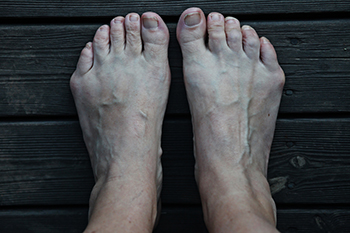
Tailor's bunions, also known as bunionettes, present a unique challenge with a bony lump on the outside of the foot around the small toe joint. While tight and ill-fitting shoes can exacerbate the issue, the exact cause of bunionettes is not fully understood. Inherited factors and the natural shape of foot bones play a significant role in bunionette formation. Causes include previous toe joint injuries, joint hypermobility, age, inflammatory arthritic conditions, tight leg muscles, and neuromuscular conditions. Footwear can also play a significant role. Tailor's bunions can cause discomfort and pain by putting pressure on the joint, bursa, and surrounding nerves. Treatment can include rest and elevation, applying a cold compress, and choosing footwear with cushioned heels, and good arch support. Further, using insoles, engaging in regular stretching and foot exercises, and exploring activities that put minimal pressure on the feet, such as swimming, may help. Weight management may also be beneficial. Footwear to avoid include wearing high heels and tight shoes, in addition to prolonged standing and walking barefoot on hard surfaces. If you have a bunionette that is causing discomfort, it is suggested that you schedule an appointment with a podiatrist for an exam and treatment options.
If you are suffering from bunion pain, contact one of our podiatrists of McKinney Podiatric Associates, PA. Our doctors can provide the care you need to keep you pain-free and on your feet.
What Is a Bunion?
Bunions are painful bony bumps that usually develop on the inside of the foot at the joint of the big toe. As the deformity increases over time, it may become painful to walk and wear shoes. Women are more likely to exacerbate existing bunions since they often wear tight, narrow shoes that shift their toes together. Bunion pain can be relieved by wearing wider shoes with enough room for the toes.
Causes
Symptoms
In order to diagnose your bunion, your podiatrist may ask about your medical history, symptoms, and general health. Your doctor might also order an x-ray to take a closer look at your feet. Nonsurgical treatment options include orthotics, padding, icing, changes in footwear, and medication. If nonsurgical treatments don’t alleviate your bunion pain, surgery may be necessary.
If you have any questions, please feel free to contact one of our offices located in Pasadena, Baytown, League City, Houston, and Pearland,TX . We offer the newest diagnostic and treatment technologies for all your foot care needs.
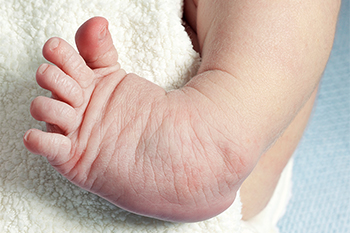
Clubfoot, a congenital condition affecting newborns, is characterized by the abnormal positioning of the foot or feet. This condition is present at birth, with the infant's foot turning inward and downward, resembling the club's head. The primary causes of clubfoot are often linked to a combination of genetic and environmental factors. While the exact genetic mechanisms are not fully understood, there is evidence of familial predisposition. Environmental factors, such as intrauterine positioning or limited space in the womb, can also contribute to the development of clubfoot. This congenital anomaly affects the muscles, tendons, and bones in the foot, leading to a tightened Achilles tendon and an imbalance in the surrounding structures. Early detection and intervention are crucial for managing clubfoot effectively. Treatment options may include gentle stretching, casting, and, in some cases, surgical procedures to correct the foot's alignment and promote proper development. If your child has been born with clubfoot, it is strongly suggested that a podiatrist is on your healthcare team who can determine what the best treatment option is for this condition.
Congenital foot problems require immediate attention to avoid future complications. If you have any concerns, contact one of our podiatrists of McKinney Podiatric Associates, PA. Our doctors can provide the care you need to keep you pain-free and on your feet.
Congenital foot problems are deformities affecting the feet, toes, and/or ankles that children are born with. Some of these conditions have a genetic cause while others just happen. Some specific foot ailments that children may be born with include clubfeet, polydactyly/macrodactyly, and cleft foot. There are several other foot anomalies that can occur congenitally. What all of these conditions have in common is that a child may experience difficulty walking or performing everyday activities, as well as trouble finding footwear that fits their foot deformity. Some of these conditions are more serious than others. Consulting with a podiatrist as early as possible will help in properly diagnosing a child’s foot condition while getting the necessary treatment underway.
What are Causes of Congenital Foot Problem?
A congenital foot problem is one that happens to a child at birth. These conditions can be caused by a genetic predisposition, developmental or positional abnormalities during gestation, or with no known cause.
What are Symptoms of Congenital Foot Problems?
Symptoms vary by the congenital condition. Symptoms may consist of the following:
Treatment and Prevention
While there is nothing one can do to prevent congenital foot problems, raising awareness and receiving neonatal screenings are important. Early detection by taking your child to a podiatrist leads to the best outcome possible.
If you have any questions please feel free to contact one of our offices located in Pasadena, Baytown, League City, Houston, and Pearland,TX . We offer the newest diagnostic tools and technology to treat your foot and ankle needs.